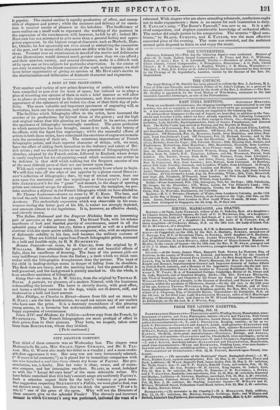A PEEP AT THE PRINT-SHOPS.
TETE number and variety of new prints deserving of notice, which we have been compelled to pass over for want of space, has induced us to adopt a plan of' recording our opinion of them in such a brief manner as will allow us to glance at every novelty in this department, and thus to announce the appearance of the ephemera of art before the close of their little day of pub- licity. The more valuable and important specimens of engraving will, as heretofore, have our best attention, and claim separate notice.
The facilities which lithography offers to the artist, have increased the number of its productions far beyond those of the graver ; and the high and original talent that this pleasing art has enlisted in its service, render the specimens of lithography increasingly excellent. The great perfection to which mezzotint° has been brought, causes it to rank, in the beauty of its effects, with the fipest line engravings ; while the successful efforts of artists in both these styles, have stimulated the exertions of engravers to main- tain the ascendancy of their art. The numerous importations of French lithographic prints, and their superior character of design, will, we trust, have the effect of adding fresh incentives to the industry and talent of Bri- tish artists ; and we should rejoice to see the practice of lithographing their sketches, adopted bY the French artists, followed in England, where design is rarely employed but for oil-painting,-and which occasions our artists to be deficient in that skill which nothing but the frequent exercise of one of the most difficult parts of their art can bestow upon them.
With such variety to tempt every taste, we scarcely know where to begin. We will first take off the edge of our appetite by a glance round DICKIN- SON'S collection' of lithographs ; then, by way of second course, feast our eyes upon the mezzotint and line engravings at Cor.xanut's ; and turn into ACKERMANN'S for the " game " and dessert, in the shape of sporting prints and coloured scraps for albums. To continue the metaphor, we pro- mise ourselves a dijeuni: in the French lithographs which we have alluded to.
Sir Thomas Lawrence-drawn on stone by W. C. Ross. The best, and indeed the only likeness that has yet appeared of the late President of the Academy. The melancholy expression which was observable in his coun- tenance during the latter _part of his life, is rather too strongly depicted, and amounts almost to the lugubrious. It is, however, an effective sketch,
and cleverly drawn. -
The Sultan Mahmoud and the Emperor Nicholas form an interesting pair of portraits at the present time. The Grand Turk, with his solemn sturdiness of look and bearded gravity of countenance, seated in all the splendid pomp of indolent luxary, forms a pictorial as well as a political contrast with the spare active soldier, his conqueror, who, with an expression of diplomatic subtilty in his face, well becomes the military costume of Europe. They are faithful copies from French lithographic prints, executed in a bold and forcible style, by H. N. HUMPHREYS. Roman Peasants-on stone, by G. CHILDS, from the original by P. WILLIAMS. More admirable for purity of tint and beautiful effects of
light, than for excellence of drawing. The faces of the peasant girls are
very indifferent translations from the Italian ; a fault which we think rests rather with the lithographic draughtsman than the painter. The head of
the child in leading-strings seems in danger of falling from its shoulders. The flesh tints are heavy, and the marking hard ; but the general effect is well preserved, and the background is prettily touched in. On the whole, it is an excellent specimen of lithography.
Going Out-on stone, by J. W. GILES, from the original by THOMAS R. Davis. A portrait, we presume, of a modern Nimrod, with the huntsman
unkennelling the bounds. The horse is cleverly drawn, with good effect, and forms a striking contrast to the dogs, which are ill 5Irawn, stiff, and shadowed in a bald and hard manner.
Miss Phillips, as Claudia in Rienzi-drawn from life and on stone, by 11. DAWE not the late Academician, we need not assure any of our readers
who have seen the print. It is a matronly resemblance of this pleasing young actress, in a favourite but unfavourable attitude, and with an un- happy expression of countenance.
Louis XI V. and Madame La ValUre-a clever copy from the French, by HUMPHREYS. The French lithographers are more prodigal of effect in their prints than in their pictures. They have, we suspect, taken some hints from BOXINGTON, whom they idolized.
(To be continued.)


















 Previous page
Previous page